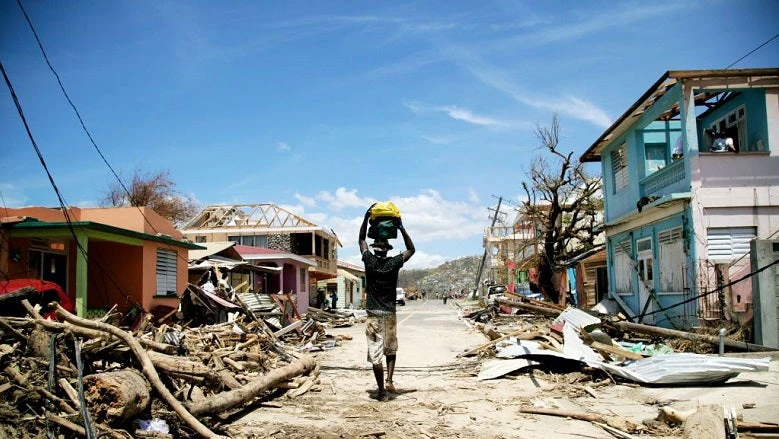
In the Caribbean, people are already living in the future. It is world where climate change can seriously affect economic growth, government decisions and people’s jobs and lives.
The recent report of the Intergovernmental Panel on Climate Change (IPCC) gave a stark warning of what happens if the world goes beyond the target of a 1.5 degree increase in temperature. At 2.0 degrees, we will see far worse droughts, floods, extreme heat and poverty for hundreds of millions of people.
Today, climate change is intensifying pressure on communities and ecosystems all over the world, but the Caribbean countries are facing quite unique challenges.
In an average year, of 12 storms that pass through the Caribbean about half reach hurricane force winds, causing annual losses equivalent to 1.6 percent of GDP. Add in other types of disasters, and average annual losses come to roughly 2.5 percent of GDP, per island per year. In terms of economic damage, this makes the Caribbean roughly 10 times more vulnerable than the rest of the world.
What is more, when mega hurricanes hit they can devastate small island economies to a much greater extent than even these averages suggest. For example, when hurricane Maria hit Dominica in 2017, damages amounted to 226% of GDP.
Caribbean nations are correctly focused on climate change adaptation, and yesterday I attended a conference with leaders from the region, jointly organized by the World Bank, the International Monetary Fund and the Inter-American Development Bank, and other partners. Together, we reflected on how we can collectively improve resilience and adaptation in the Caribbean.
Countries like Jamaica, Grenada, St. Lucia, Dominica, and St. Vincent and the Grenadines are investing in adaptation, and actively exploring the financial instruments that can provide insurance and transfer risks presented by extreme weather events. Their experience suggests three areas of focus to reduce the impact of climate change natural disasters.
First, invest in preparation. This means increasing the resilience of public infrastructure and private businesses by having early warning systems in place to help save lives and reduce damages. And, of equal importance, is to prioritize the interventions.
Second, create rainy day funds and deploy insurance. This means saving more during good times to be ready for the next disaster, implementing counter-cyclical fiscal policies and designing mechanisms to transfer risks to markets through risk-pooling across countries. For example, the Caribbean Catastrophe Risk Insurance Facility (CCRIF) is an insurance mechanism that provides rapid payouts to ease short term cash flow problems that some small economies face in the aftermath of a disaster. Following the 2017 hurricanes, eight Caribbean countries received payouts from the CCRIF totaling over $50 million.
Third, protect the most vulnerable and use adaptive safety nets. Following a hurricane, a key issue is to ensure delivery and continuity of health, education, and other key public services , that typically get interrupted for long time periods after disasters. In Dominica and Sint Maarten, the World Bank is working with the governments to improve the efficiency of social services and identify the most vulnerable populations who need assistance the most in post-disaster situations.
Across the world consequences of climate change are already far more dramatic than we initially envisaged. We are seeing severe wild fires, unprecedented storms, disastrous floods and droughts. Without urgent action, an additional 100 million people could be pushed into poverty. The effects of climate change are upon us and the time to act is now. And the countries of the Caribbean are loudly calling for it. They tell us that investing in climate resilience and adaptation is an urgent necessity. If we get it right, then our infrastructure will be stronger and smarter, and we will have the financial resources to quickly respond when disaster strikes. Get it wrong or move too slowly, and millions of people will lose their homes and livelihoods and be driven into poverty.
At the World Bank we hear this call and are stepping up financing for climate action. In 2018, we invested a record-breaking $20.5 billion in climate mitigation and adaptation, meeting our 2020 climate target two years ahead of schedule. Next week, we will launch new climate targets and our Adaptation and Resilience Action Plan. Most important for vulnerable countries like those in the Caribbean, we are putting adaptation front and center on the global agenda. And I am already working with Bill Gates and Ban Ki-moon as co-chairs of the Global Commission on Adaptation that will elevate the issue and share evidence and best practice on accelerating adaptation action.
Governments, business and citizens in the Caribbean have woken up to the reality of climate change because nature has devastated their communities. They are taking action now, but they know there is more to do. Other countries have had similar experiences, which foreshadow more pain to come unless the world learns from their experiences before it is too late.


Join the Conversation